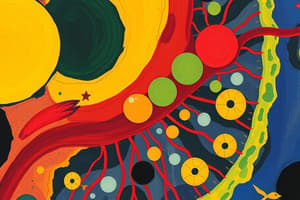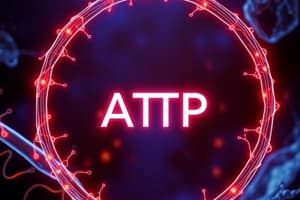Podcast
Questions and Answers
Which of the following structures is primarily involved in the formation of chemical energy?
Which of the following structures is primarily involved in the formation of chemical energy?
- Microtubules
- Neurofibrils
- Lysosome
- Mitochondria (correct)
What is the primary function of neurofibrils in a neuron?
What is the primary function of neurofibrils in a neuron?
- Storing neurotransmitters
- Transporting nutrients
- Determining the shape of the neuron (correct)
- Generating electrical impulses
Which structure is responsible for cellular waste management within the cell?
Which structure is responsible for cellular waste management within the cell?
- Lysosome (correct)
- Microfilaments
- Axon hillock
- Centrioles
What type of filaments form a dense network beneath the plasma membrane and play a role in cell transport?
What type of filaments form a dense network beneath the plasma membrane and play a role in cell transport?
In which part of the neuron is the axon hillock located?
In which part of the neuron is the axon hillock located?
Which component of the neuron is described as having a fan-shaped structure?
Which component of the neuron is described as having a fan-shaped structure?
What is the role of centrioles in the cell?
What is the role of centrioles in the cell?
What diameter range do microtubules typically have?
What diameter range do microtubules typically have?
Which of the following statements accurately describes lipofuscin?
Which of the following statements accurately describes lipofuscin?
What is the main characteristic of the plasma membrane in a neuron?
What is the main characteristic of the plasma membrane in a neuron?
What type of transport is associated with kinesin in neurons?
What type of transport is associated with kinesin in neurons?
What characterizes slow transport in neurons?
What characterizes slow transport in neurons?
Which motor protein is primarily responsible for bringing organelles back to the cell body?
Which motor protein is primarily responsible for bringing organelles back to the cell body?
What is the maximum speed associated with rapid transport in neurons?
What is the maximum speed associated with rapid transport in neurons?
Which process involves the bulk movement of organelles in neurons?
Which process involves the bulk movement of organelles in neurons?
In the context of neural transport, what controls the direction and speed of movement?
In the context of neural transport, what controls the direction and speed of movement?
What is the role of adenosine triphosphate (ATP) in rapid transport?
What is the role of adenosine triphosphate (ATP) in rapid transport?
Which statement best describes the difference between rapid and slow transport?
Which statement best describes the difference between rapid and slow transport?
What is the primary neurotransmitter used in all skeletal neuromuscular junctions?
What is the primary neurotransmitter used in all skeletal neuromuscular junctions?
Which process occurs first during the action of neurotransmitters?
Which process occurs first during the action of neurotransmitters?
What determines the excitatory or inhibitory effects of neurotransmitters on the postsynaptic membrane?
What determines the excitatory or inhibitory effects of neurotransmitters on the postsynaptic membrane?
During synaptic transmission, what role do calcium ions play?
During synaptic transmission, what role do calcium ions play?
Which of the following neurotransmitters is NOT classified as an inhibitory neurotransmitter?
Which of the following neurotransmitters is NOT classified as an inhibitory neurotransmitter?
What is the primary role of sodium ions during nerve cell excitation?
What is the primary role of sodium ions during nerve cell excitation?
Which statement accurately describes the action potential?
Which statement accurately describes the action potential?
What characterizes the refractory period in nerve cells?
What characterizes the refractory period in nerve cells?
How is the strength of an initial stimulus related to the subsequent depolarization?
How is the strength of an initial stimulus related to the subsequent depolarization?
What is a consequence of summated excitatory stimuli in neuron activity?
What is a consequence of summated excitatory stimuli in neuron activity?
Which type of molecular motor is believed to be involved in slow axonal transport?
Which type of molecular motor is believed to be involved in slow axonal transport?
What is the primary function of sodium and potassium channels in the membrane?
What is the primary function of sodium and potassium channels in the membrane?
Which of the following correctly describes the conduction of an action potential?
Which of the following correctly describes the conduction of an action potential?
What is the function of retrogade transport in nerve cells?
What is the function of retrogade transport in nerve cells?
Which structure on the neuron is considered the site where impulses are generated?
Which structure on the neuron is considered the site where impulses are generated?
Which type of synapse is characterized by communication between the axon of one neuron and the soma of another?
Which type of synapse is characterized by communication between the axon of one neuron and the soma of another?
What characteristic distinguishes larger diameter axons from smaller diameter axons?
What characteristic distinguishes larger diameter axons from smaller diameter axons?
What forms the plasma membrane surrounding the axon?
What forms the plasma membrane surrounding the axon?
What is the primary component of the axoplasm?
What is the primary component of the axoplasm?
Which of the following describes the function of varicosities in axons?
Which of the following describes the function of varicosities in axons?
What best describes the directionality of synaptic communication?
What best describes the directionality of synaptic communication?
Flashcards are hidden until you start studying
Study Notes
Cell Structures Related to Neurons
- Mitochondria: Spherical, double-membraned organelles with cristae vital for chemical energy production; scattered throughout the cell.
- Neurofibrils: Linear fibrils (10 nm) made of microfilament bundles that give shape to neurons; run parallel from dendrites through the cell body to the axon.
- Microfilaments: Thin filaments (3–5 nm) forming a dense cytoskeletal network beneath the plasma membrane; involved in cell retraction and transport.
- Microtubules: Larger linear tubes (25 nm) that facilitate cell transport; extend from dendrites through the cell body to the axon.
- Lysosomes: Small vesicles (8 nm) acting as cell scavengers, containing primary, secondary, and residual forms; involved in waste processing.
- Centrioles: Paired hollow cylinders of microtubules, localized to the cell body cytoplasm; play a role in cell division and microtubule maintenance.
- Lipofuscin: Yellowish-brown granules scattered in the cytoplasm; they represent metabolic by-products derived from lysosomal activity.
- Melanin: Yellowish-brown granules found in the substantia nigra of the midbrain; associated with dopamine formation.
- Plasma Membrane: Fluid-like membrane facilitating the initiation and conduction of nerve impulses; characterized by rapid and slow axonal transports.
Impulse Conduction and Action Potentials
- Depolarization: Occurs when Na+ ions diffuse into the cell cytoplasm due to neuronal excitation.
- Action Potential: A brief occurrence lasting about 5 msec; spreads along the plasma membrane as a self-propagated nerve impulse.
- Refractory Period: Nonexcitable state where a new action potential cannot be generated; helps regulate impulse frequency.
- Sodium and Potassium Channels: Integral proteins that participate in the depolarization process; essential for maintaining ionic balance during nerve impulses.
Axon Structure and Function
- Axon: Longest process extending from the cell body; conducts nerve impulses away from the neuron.
- Axon Hillock: Conical elevation where the action potential is initiated.
- Axon Terminals: Distal ends of axon branches where communication occurs with other neurons.
- Varicosities: Swellings of autonomic axons resembling beads; involved in neurotransmitter release.
- Axolemma and Axoplasm: Plasma membrane and cytoplasm of the axon, respectively; axoplasm lacks Nissl granules and Golgi complex.
- Initial Segment: Most excitable part of the axon critical for action potential generation.
Synaptic Transmission
- Synapse: Junction where neurons communicate; can be synapses between axon and dendrite (axodendritic), axon and soma (axosomatic), or axon to axon (axoaxonic).
- Chemical Synapses: Involve neurotransmitter release, which diffuses across the synaptic cleft and binds to postsynaptic receptors; includes neurotransmitters like acetylcholine, dopamine, serotonin, and GABA.
Mechanism of Neurotransmitter Action
- Neurotransmitters are released upon nerve impulse arrival, leading to calcium influx, synaptic vesicle fusion, and release into the extracellular fluid.
- The effect on the postsynaptic neuron varies based on overall summation of excitatory and inhibitory signals; depolarization can trigger action potentials and propagate nerve impulses.
Transport Mechanisms
- Rapid Transport: Achievable speeds of 100 to 400 mm per day using motor proteins kinesin (anterograde) and dynein (retrograde).
- Slow Transport: Slower movement (0.1 to 3.0 mm per day) involving cytoplasm transport, primarily anterograde, likely mediated by a kinesin family motor.
Studying That Suits You
Use AI to generate personalized quizzes and flashcards to suit your learning preferences.





